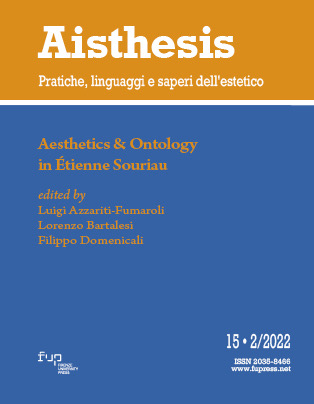Published 2023-02-06
Keywords
- .
How to Cite
Abstract
Étienne Souriau was a refined and demanding thinker, with an aristocratic demeanour, far removed from the currents of ideas dominant in his time. A difficult and erudite author, out of tune with the times he lived in, he would seem the least likely candidate to appeal to a hurried and globalised public like that of the twenty-first century. A sophisticated representative of a rationalist positivism, no stranger to the Husserlian canon and not even insensitive to the motivations dear to the gnoseological debate of Cartesian and Kantian matrix (as well as to the major themes of classical metaphysics), Souriau pursues the ideal of a constructive philosophy, capable of understanding – and at the same time favouring – the advancement of the creative process conceived as a set of poetic acts and progressive dynamic operations. In his texts, Souriau is attentive to grasping the correspondences, exchanges and reciprocal transitions between one mode of existence and another, as well as the resonances between the various art forms in the different fields of knowledge, testing an original method that is epistemologically very fruitful.
The aim of this monographic issue of Aisthesis dedicated to Étienne Souriau is to explore his thought in its multiple aspects, in order to measure its topicality in relation to the themes and problems that characterise contemporary philosophical debate, with particular reference to aesthetics and ontology as well as to the dense network of connections between the two fields. One of the most interesting characteristics of Souriau’s thought that has stood the test of time would appear to be its multifacetedness: the quality of lending itself to being applied even to spheres that are apparently very distant from reflection on art, such as cultural anthropology, political philosophy or morality. It seemed to us that it largely owes its relevance precisely to the intersections between one field of knowledge and another.
The issue contains twelve contributions on Souriau that explore his main aspects in depth. They range from analyses devoted to the architecture of Souriau’s thought (his general philosophy) in the essays by Dominique Chateau and Filippo Domenicali, which can furnish a useful overall picture of the man, to essays that attempt to focus on the more properly ontological core of this thought, such as those devoted to the arabesque motif (Luigi Azzariti-Fumaroli), the theory of the soul (Sjoerd Van Tuinen) or the multiplicity of worlds (Noëlie Plé). Interspersed between these are contributions that focus more on the comparison between Étienne Souriau’s thought and the philosophers of his time, such as Dufrenne (Maryvonne Saison), or with well-known later philosophers who explicitly referred to him, prolonging his creative impetus, such as Gilles Deleuze (Casey Boyle) and Bruno Latour (Aline Wiame), the true architect of the current Souriau “comeback”. Finally, in addition to essays of a more theoretical nature, there are contributions that attempt to re-evaluate certain aspects of Souriau’s aesthetics, such as the fruitfulness of the cues that can come from his thought for the debate on animal aesthetics (Maddalena Mazzocut-Mis and Andrea Scanziani), or the possible topicality of his theory of forms (Isabelle Rieusset-Lemarie).
In the “Miscellaneous” section, this issue hosts a number of studies that aim to explore the aesthetic implications of new technologies, the themes of ecological aesthetics, as well as to offer an unusual profile of Baumgarten.


